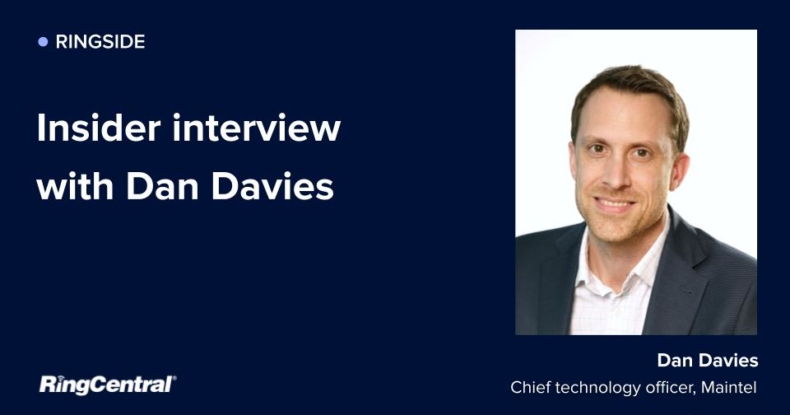Welcome back to Ringside. This series looks at trends across the business communications landscape today. To gain this level of insight, we ask the experts for intel. Information and technology leaders share their thoughts on how the sector has changed throughout the years, and what is going to impact it in the future.
For this episode, we ‘sat down’ with Dan Davies, chief technology officer at Maintel, a cloud and managed services company with a focus on communication. The company is made up of experienced, trusted technology advisors that improve their clients’ organisations through digital transformation. Maintel make its customers’ employees more efficient, effective and collaborative through Digital Workplace technology. The company helps clients retain, acquire and delight their customers with Customer Experience tools. Finally, it connects employees, partners, suppliers and customers to their applications and data through secure connectivity.
Dan, what’s your role at Maintel, and what do you love about your job?
I’m the CTO, responsible for ensuring that our technology strategy underpins our business strategy and delivers effortless communication capabilities to our customers. I love being a part of providing business-critical communications services to a diverse set of public and private sector organisations, and knowing these services enable them to achieve their strategic priorities.
On top of this, I’m passionate about delivering meaningful outcomes to our customers, not just great technology. I’m particularly proud of the support we’ve been able to provide to our many amazing NHS customers throughout the pandemic, ensuring their communications aren’t something they need to worry about!
In what ways has business communications changed over your career?
Business communications has changed beyond all recognition since I started my career in 2000. The first office I worked in was connected to the internet via a 56k modem connected to the back of a server. Excitingly, the business upgraded this to a 256k KiloStream service shortly after I joined. Our mobile phones were decidedly un-smart. GPRS & WAP being the new big (but largely completely unusable) things to keep us connected to the web, and carrying my laptop around was a good weight training alternative.
I have less than fond memories of trying to pair up my PDA via Bluetooth to my mobile to allow me to pick up email over its GPRS connection, and it taking an entire hour-long train journey before I managed to download any! So for me, the most significant change and the enabler for the connected world we live in today has been the exponential growth of the internet. More specifically, the technological leaps we’ve made in both wired and wireless access technology bandwidth, coverage and reliability.
There’s been a complete flip, from a world where we did everything offline and only “connected” when we had to, to a world where our laptops and phones are practically useless without an internet connection. This has transformed the communications industry. The adoption of IP based technologies could not have been possible without this technological advance, which has, in turn, enabled the rich, always-on communication, collaboration, digital customer engagement and ubiquitous connectivity we often take for granted today.

Can you describe any interesting announcements or trends you’ve spotted in the industry?
For me, distributed cloud is the next significant evolution in cloud computing. It takes edge computing to the next level. With distributed cloud, the edge deployment is wholly owned and run by the originating cloud provider, who remains responsible for the service’s evolution and innovation. Today, some “Edge” services already fit this model, whereas some are software deployments on a customer-owned bare-metal server environment. Conversely hybrid cloud is typically a completely customer-owned and managed (or co-managed) on-premises environment that integrates with a core cloud service rather than being part of it.
The initial distributed cloud deployments will each be dedicated to a specific customer. However its evolution will see the likes of telcos, universities and local government deploy distributed cloud nodes and use them to offer distributed cloud services to their neighbouring local organisations. Think WiFi hotspots in terms of a similar shared model concept.
Communications software as a service (SaaS) providers will, in my mind, no doubt start looking to adopt distributed cloud technology. Click To Tweet
Distributed cloud will be a major factor in infrastructure as a service (IaaS) before reaching the communications industry. Although communications software as a service (SaaS) providers will, in my mind, no doubt start looking to adopt distributed cloud technology themselves. This will allow them to begin addressing the use cases they struggle to meet today with pure public cloud. For example, seamless local survivability, high-density analogue connectivity, emergency phones and local integrations with on-premises systems such as paging platforms.
The power of the platform will continue to dominate the communications industry for the foreseeable future. It’s not enough for a SaaS vendor to have one or more great “turnkey” applications anymore. They must also use their underlying platform to integrate a rich ecosystem of third-party applications to complement their core service and cater to the edge cases that they can’t meet on their own. They must also expose the power of their platform via rich APIs so that the customers who choose to can create their own bespoke experiences and outcomes.
The power of the platform will also dominate the communications industry for the foreseeable future. It's not enough for a SaaS vendor to have one or more great turnkey applications anymore. Click To Tweet
Building on the trends Dan spoke about, there’s no doubt that cloud deployments are processing increasingly bigger and costlier datasets, making edge computing a growing priority.
Gartner predicts that by 2022, over half of all data generated by businesses will be produced and processed away from traditional cloud data centres, increasing to 75% by 2025. The move towards cloud processing at the edge is encouraging businesses to consider a distributed model as the next stage of their cloud migration. Find out more about Dan and Maintel on LinkedIn.
Originally published Mar 25, 2021

